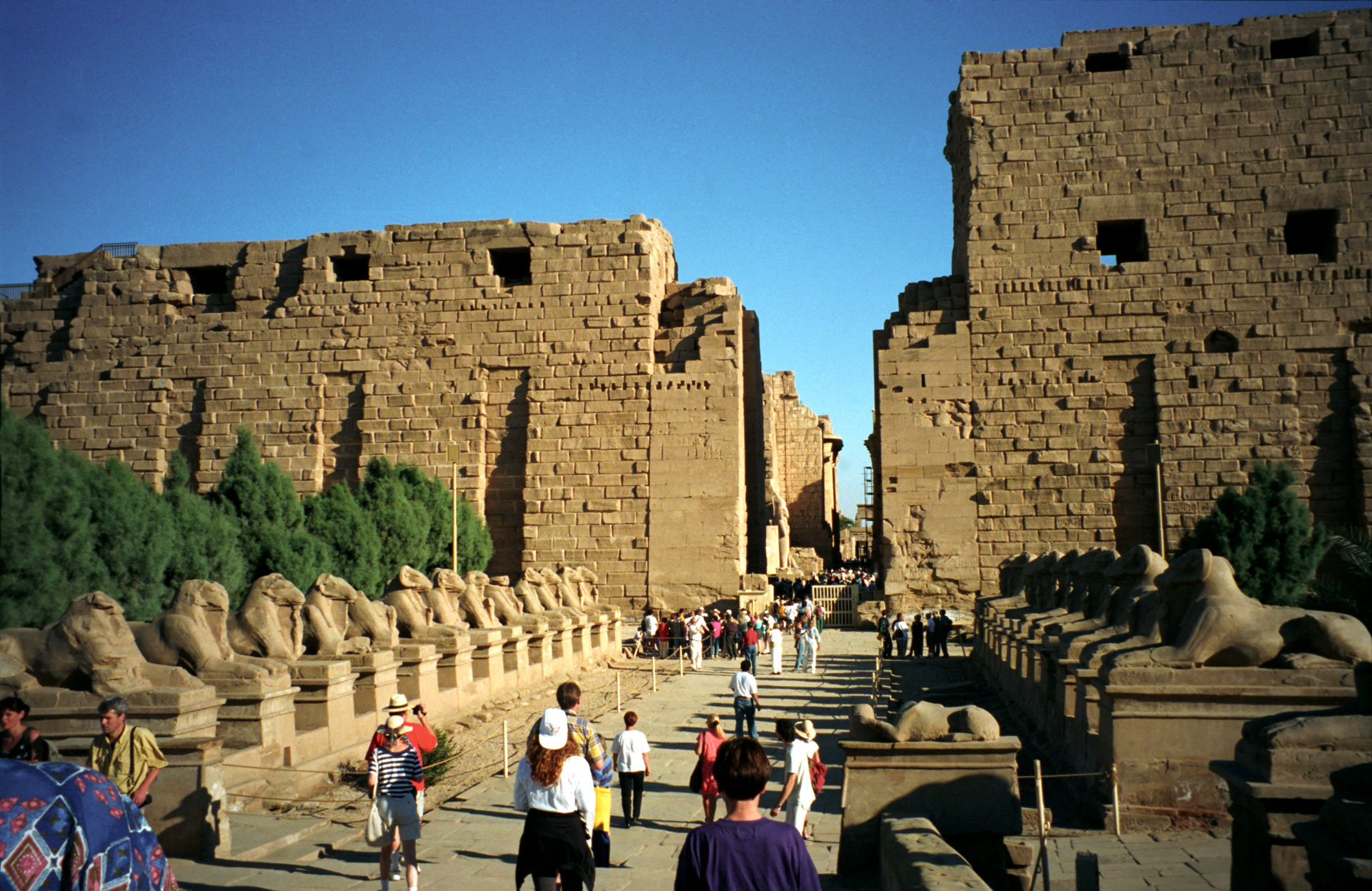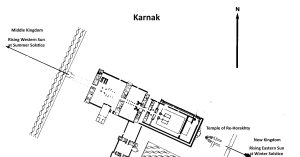 Sometimes we just need to listen carefully. Definitely in regard to Karnak.
Sometimes we just need to listen carefully. Definitely in regard to Karnak.
Egyptian priests told Herodotus, a careful listener, that four times since Egypt had become a kingdom “the Sun rose contrary to his wont; twice he rose where he now sets, and twice he set where he now rises.”
This evidence, and much else, was interpreted by Immanuel Velikovsky, another careful listener, in his Worlds in Collision (1950) in connection with his theory that Venus had emerged from Jupiter and repeatedly approached Earth during the Bronze Age. New evidence and reinterpretation make it clear that Velikovsky was basically right. As the Greek Metis myth tells us, Venus did not emerge from Jupiter but was rather pulled by its immense gravity from outer space. Turned into a molten comet by tidal heating as it passed Jupiter, Venus headed into the inner solar system. It approached Earth every 52 years, and on four occasions came close enough to cause major catastrophes reported by the ancients. Most likely, it was during these close approaches9 that Earth turned over, accounting for the eastern and western risings of the Sun. Velikovsky ascribed this to electromagnetic forces, but gravitational interaction seems a more likely cause.
Velikovsky’s critics found plenty of mistakes in his writings; but they failed to listen carefully enough to the many pieces of evidence that he had collected and to the arguments he made about Venus. Even if they could not accept his arguments, they should have refrained from rushing to judgment, rejecting everything he had to offer, and stigmatizing him in what has become the greatest case of scientific rejectionism in modern times. The correct approach would have been to investigate further. Now that others have done so, a steadily accumulating array of telling evidence and reinterpretation has resolved this controversy, though this is not widely known.
Some of this evidence relates to Egypt. We know, for example, that the Great Sphinx was an effigy of Venus built just before 2500 BC when Venus first approached the Earth in an awesome way. We can use new estimates of the approximate dates of the four close approaches—2200, 1628, 1210, and 820 (less likely, 687) BC—to explain the chronology of Egypt.
- During the Old Kingdom (2686-2160 BC), which came to an end soon after the 2200 BC inversion, the Sun rose in the east.
- During the First Intermediate Period (2160-2055 BC) and Middle Kingdom (2055 BC-1650 BC), the Sun rose in the west.
- After the second inversion around 1628 BC (or possibly 1680 BC) came the Second Intermediate Period (1650-1550 BC) and New Kingdom (1550-1210 BC) when the Sun rose in the east. (Both Egyptian chronology and the estimated dates of inversions are approximate.)
- After the third inversion around 1210 BC came the Third Intermediate Period (1069-664 BC). The Sun rose in the west until 820 BC.
- From 820 BC on, the Sun rose in the east.
It usually took at least a few decades for the catastrophes set off by the inversions to bring about the final demise of the kingdoms.10
West and East at Karnak
 Karnak, just north of Thebes, was the greatest temple complex in ancient Egypt and the center of Egyptian religion during the second millennium BC. It was built in the period of 2050-1950 BC, at the end of the First Intermediate Period and the start of the Middle Kingdom. The Great Temple of Amon-Re is built along an axis that runs from WNW to ESE, perpendicular to an old channel of the Nile and across from the Theban Hills on the West Bank.
Karnak, just north of Thebes, was the greatest temple complex in ancient Egypt and the center of Egyptian religion during the second millennium BC. It was built in the period of 2050-1950 BC, at the end of the First Intermediate Period and the start of the Middle Kingdom. The Great Temple of Amon-Re is built along an axis that runs from WNW to ESE, perpendicular to an old channel of the Nile and across from the Theban Hills on the West Bank.
In The Dawn of Astronomy11, British astronomer Norman Lockyer argued that the Great Temple was oriented toward the setting sun at summer solstice so that the last rays would pass down the axis and illuminate the statue of the god in the sanctuary. However, the rays of the setting sun were found to be blocked from penetrating the temple along its axis.12 Later researchers, most notably Gerald Hawkins, identified at least four ways in which the temple appeared to be oriented in the opposite direction, toward the rising Sun at winter solstice.13 King/Queen Hatshepsut had a temple built to Amon-Re-who-hears-the-prayers facing ESE; it backed on the original sanctuary that had appeared oriented toward the WNW. After her death, Tuthmosis III built a Festival Hall facing ESE that blocked her temple. The Hall contained a chapel up a flight of stairs that opened to the east; Hawkins dubbed this the High Room of the Sun. Ramses II added a separate Temple of Re Horakhty along the line of the axis and oriented ESE (this had already been identified by Lockyer).14
Thus some researchers have held that the real orientation of the overall temple was to the east. However, that leaves the evident original orientation toward the west unexplained.
Theory to the Rescue
In fact, the explanation is simple: the temple was originally constructed at the outset of the Middle Kingdom, a time of the Western-Rising Sun. It was oriented toward the WNW so that the first rays of the rising Sun at the summer solstice would penetrate down the axis and illuminate the statue of the god. However, that leaves a different question unanswered: How would they penetrate if they were blocked by the Theban Hills? The answer seems to be that the Western-Rising Sun at the outset of the Middle Kingdom had a slightly different trajectory than the setting Eastern-Rising Sun that Lockyer had proposed, so that by the time its rays would surmount the Theban Hills it would be farther along its trajectory from a notional level horizon.15
At any rate, it seems clear that the return to an Eastern-Rising Sun after the ca 1628 BC inversion led to the four attempts during the New Kingdom to provide a structure oriented toward the east. (Hatshepsut’s Djeser-Djeseru temple can be counted as a fifth, facing ESE directly across the Nile from Karnak, with its western orientation.) These efforts ceased at the time of the ca 1210 BC inversion and return to a Western-Rising Sun until an inscription dated ca 840 BC, which said: “One climbs the Aha, the lonesome place of the majestic soul, the high room [the High Room of the Sun] of the intelligence which moves across the sky; one now opens the door of the horizon building of the primordial god of the two countries in order to see the mystery of Horus shining.”16 This can best be interpreted as more properly dated a decade or two later and as having the purpose of expressing bewonderment at and reverence for the new Eastern-Rising Sun after the inversion of ca 820 BC (which itself might have occurred a decade or two earlier).
Conclusion
This account of the orientation of the Great Temple at Karnak has several implications. First, we can see that the theory of inversions enables us much better to understand the rhythm of ancient Egyptian history. In particular, the catastrophes of the three Intermediate Periods gain a powerful triggering cause that fully justifies the lamentation literature and other reports of devastation and chaos. Egyptian civilization attained many of its greatest achievements in the teeth of terrible catastrophes. Second, we can better interpret the evolution of Egyptian religion and myth. For example, while the chain of causality leading to the famous episode of Akhenaten’s solar orb monotheism remains obscure, the two previous switches of the Sun between Eastern-Rising and Western-Rising must have set people thinking about the Sun itself, and this led to Akhenaten’s new theology. Even as Akhenaten preached a solar monotheism, the solar orb he worshipped, in conjunction with the horns of Hathor (the twin cometary tails), originally symbolized Venus. So there was confusion and ambiguity. Third, understanding Karnak can help us interpret many other ancient orientations around the world, including buildings and open air sites.
Karnak’s orientation is one more piece of evidence of the correctness of the Revised Venus Theory that brings Immanuel Velikovsky’s pioneer theory up to date.
*****
Kenneth J. Dillon is a historical and scientific researcher. See the biosketch at About Us.
